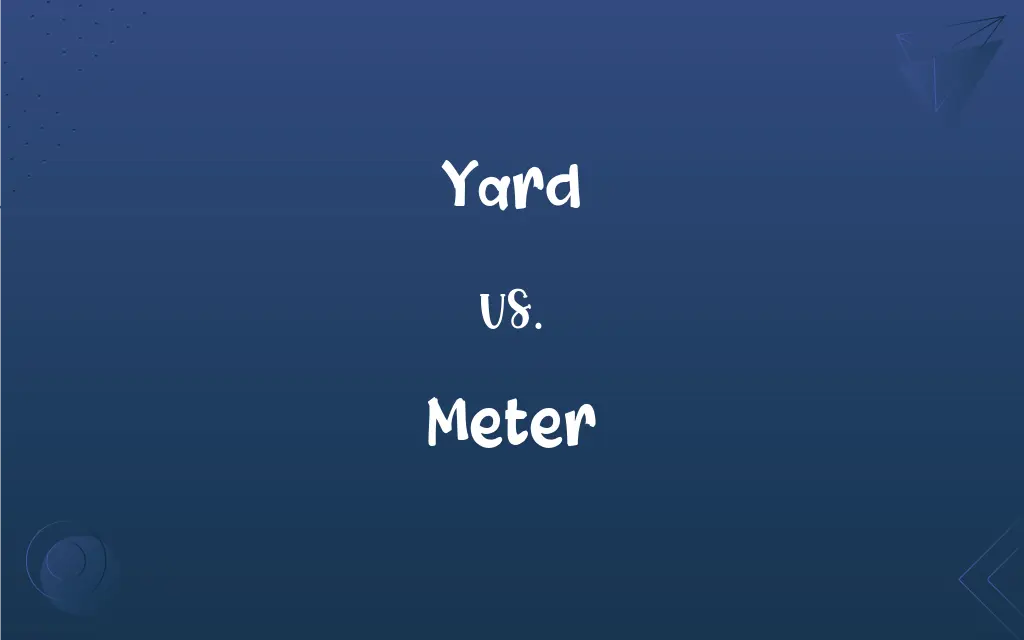Yard vs. Meter: What's the Difference?
By Janet White || Published on December 13, 2023
A yard is a unit of length in the imperial system, equal to 3 feet or 0.9144 meters, while a meter is the base unit of length in the metric system, equal to 100 centimeters.

Key Differences
The yard, with origins in the English system, has been used since the Middle Ages. It was initially based on the length of a man's belt or girdle. In contrast, the meter, originating from the French metric system, was introduced in the late 18th century, conceptualized as one ten-millionth of the distance from the equator to the North Pole.
Today, the yard is commonly used in the United States and the United Kingdom for measuring distances, like in football fields. The meter, however, is widely used worldwide in scientific, engineering, and everyday contexts due to its status as the standard unit in the International System of Units (SI).
A meter is precisely defined based on the speed of light, making it extremely accurate for scientific purposes. In comparison, a yard is less precise but still widely used. One yard equals 0.9144 meters.
In countries using the imperial system, the yard is part of cultural identity, especially in sports and construction. The meter, recognized globally, symbolizes the universal adoption of the metric system, promoting standardization and ease in international collaboration.
For everyday use, the difference between a yard and a meter might not be significant, but in fields like engineering, science, and international trade, using the metric system and meters ensures accuracy and standardization.
ADVERTISEMENT
Comparison Chart
System
Imperial system
Metric system
Length
Equal to 3 feet or 36 inches
Approximately 39.37 inches
Usage
Common in the US and UK
Used globally, especially in scientific work
Historical Origin
Medieval England
18th century France
Precision
Less precise
Highly precise
ADVERTISEMENT
Conversion
1 yard = 0.9144 meters
1 meter = 1.09361 yards
Measurement Focus
Used in shorter distances
Preferred in scientific and precise measures
Global Adoption
Limited to few countries
Universally adopted
Symbolic Meaning
Traditional measurement
Modern, standardized measurement
Yard and Meter Definitions
Yard
An enclosed area for a specific purpose, like a lumberyard or railyard.
The old railyard has been converted into a museum.
Meter
A meter is the base unit of length in the metric system, equal to 100 centimeters.
The new table is two meters long.
Yard
In nautical terms, a yard is a horizontal spar from which a sail is suspended.
The ship's yard was damaged in the storm.
Meter
A parking meter is a device for collecting money in exchange for the right to park a vehicle in a particular place for a set amount of time.
She put coins in the meter to park her car downtown.
Yard
An outdoor area adjacent to a building.
The children played in the front yard.
Meter
In physics, a meter is used as a standard unit for measuring various quantities like wavelength.
The scientist calculated the wavelength in meters.
Yard
A unit of volume for fabric or other goods, measured in linear terms.
She purchased three yards of silk for her dress.
Meter
A rhythmical pattern in music or poetry.
The poem's meter gave it a melodious rhythm.
Yard
A yard is a unit of length equal to 3 feet.
He measured the length of the room in yards.
Meter
A device used to measure and record the quantity of a substance.
The taxi driver turned on the fare meter as soon as I got in.
FAQs
What is a meter?
A meter is the base unit of length in the metric system, equal to approximately 39.37 inches.
Are yards and meters used interchangeably?
No, they belong to different measurement systems and are not directly interchangeable.
Which countries primarily use the yard?
The United States and the United Kingdom primarily use yards.
Can yards be used in scientific measurements?
While possible, meters are preferred in scientific contexts for precision and standardization.
What is the historical origin of the yard?
The yard dates back to the Middle Ages in England.
What is the historical origin of the meter?
The meter was introduced during the French Revolution as part of the metric system.
What is a yard?
A yard is a unit of length in the imperial system equal to 3 feet or 36 inches.
How many meters are in a yard?
One yard is approximately 0.9144 meters.
Why is the meter considered more precise?
The meter is defined by the speed of light, a constant in physics, making it extremely precise.
Is the yard still relevant today?
Yes, especially in countries that use the imperial system for everyday measurements.
Are there any common objects that are about a yard long?
A standard baseball bat is roughly a yard long.
Are there any common objects that are about a meter long?
A guitar is approximately a meter in length.
How do you convert yards to meters?
Multiply the length in yards by 0.9144 to convert to meters.
How is a meter used in everyday life?
A meter is used in a variety of contexts, from construction to scientific research.
Is the meter used internationally?
Yes, the meter is the standard unit of length in the International System of Units (SI) and is used globally.
Is the meter used in the Olympics?
Yes, all athletic events in the Olympics are measured in meters.
How do you convert meters to yards?
Multiply the length in meters by 1.09361 to convert to yards.
How is a yard used in everyday life?
A yard is often used in everyday life for measuring shorter distances, like in gardening or fabric measurement.
Can the yard and meter be used in navigation?
Yes, both can be used, but the meter is more common in modern navigation systems.
Is the yard used in professional sports?
Yes, especially in American football, where the field is measured in yards.
About Author
Written by
Janet WhiteJanet White has been an esteemed writer and blogger for Difference Wiki. Holding a Master's degree in Science and Medical Journalism from the prestigious Boston University, she has consistently demonstrated her expertise and passion for her field. When she's not immersed in her work, Janet relishes her time exercising, delving into a good book, and cherishing moments with friends and family.































































